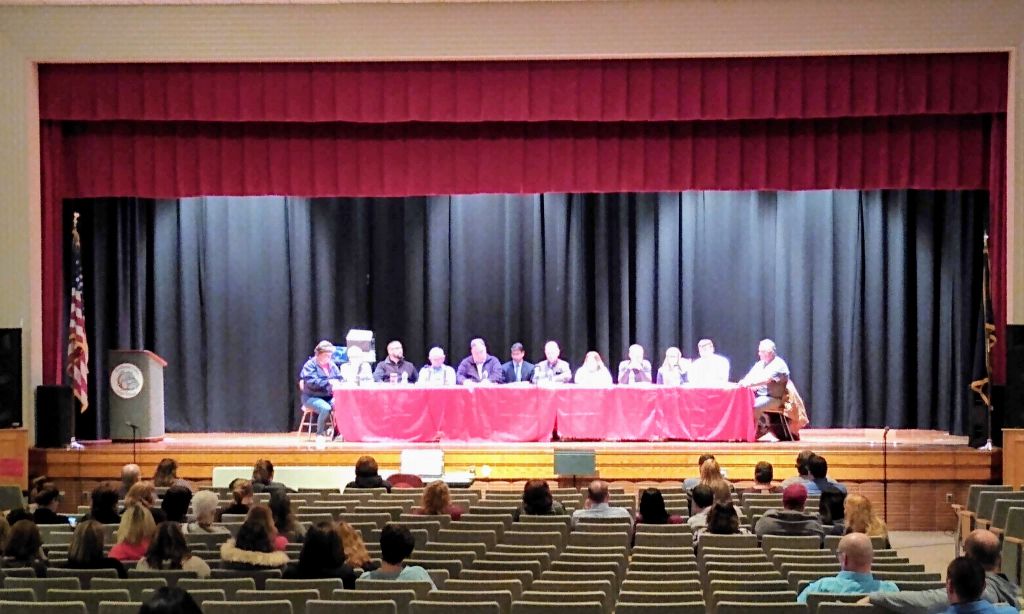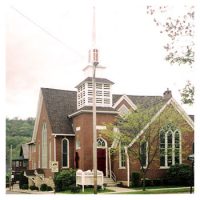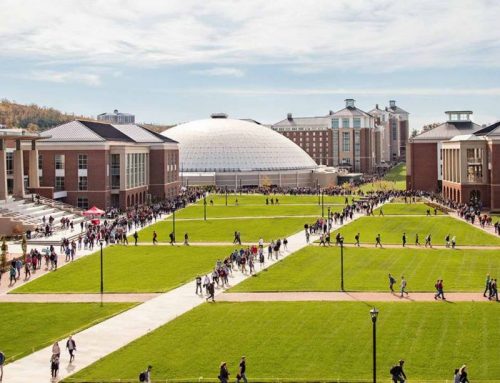COMMUNITY SPOTLIGHT
LOCAL NEWS
Referendum – How We Got Here
NEW BETHLEHEM, Pa. by: John Gerow (RVO) – Public schools have a long history in the United States. Settlers in New England and the Middle Atlantic colonies organized public schools early in their development. The earliest Europeans in these colonies placed high value in reading as befit their religious need to read the Bible. While few of these schools were “free” as we consider schools should be, they were all funded, in part, through public efforts. Parents would provide “room and board” for unmarried school teachers. Local folk would provide fire wood for heating the schools, and communities would undertake various fundraisers to pay the teachers’ wages. In the decades following the American Civil War, public schools were common in most of the country and the practice of taxing real property to fund schools was well established. Real Property taxes are one of the major sources of local funding for public schools.
 *Photo courtesy of Matt Green of TechReady Professionals & RedbankValley.org
*Photo courtesy of Matt Green of TechReady Professionals & RedbankValley.org
As with most aspects of public schooling, the individual state governments dictate how local school boards can raise and collect taxes. Here in the Commonwealth, the Pennsylvania Department of Education (PDE) controls school property taxes. Among other controls, the PDE limits how much school districts can increase property taxes without a referendum vote and how much Reserve Funds a school district can hold before going to the voters with a referendum. The agency also sets procedural guidelines that school districts must fulfill when developing a referendum. Until just the last few years, the Redbank Valley School District had enough Fund Reserve Balances, to prevent the Board from raising taxes beyond the PDE limit or the “Act 1 Index”.
In 2006, the Pennsylvania Legislature passed Act 1 of the Pennsylvania Tax Payer Relief Act, which defines how much school districts can raise taxes without voter approval. The PDE calculates the “index” annually based on average educational wage increases in the state and nation and then, PDE adjusts that index to local economic conditions. PDE calculates an individual index for each of the school districts in the state. Act 1 also allows for above index tax increase if special education or retirement funding increased above the index amount in the two previous years. This index is different for every school district and changes from year to year.
Compounding the statutory limitations imposed by the state, is the idea that no tax collecting entity should ever have surplus funds. People who hold to this idea think that if any government runs a surplus, it means that the entity has taken too much money from the people. This philosophy believes that governments should only take in taxes the bare minimum it needs to provide services. More than few of the Redbank Valley School Directors held this point of view during the years of large Fund Reserve Balances. There is also the belief within the community that some large property owners have served on the school board, primarily to block tax increases. And so, state regulations, attitudes toward taxes, and the resulting deficit spending set Redbank Valley on its recent, historic course.
Like multiple, unstable low-pressure systems converging on an unsuspecting geography, the pattern of spending set up by state mandates and attitudes toward taxes have created a “perfect storm” of financial nightmares for Redbank Valley School District. Patterns of spending and necessary services have outpaced the District’s ability to pay for them at current revenue levels. Even raising property taxes by the state index will leave the District short by nearly $800,000 next school year.
At the special meeting on February 24, the School Board presented their argument for passing the tax referendum. The Board presented documentation showing that Redbank Valley has the lowest tax rate per student in both Clarion and Armstrong Counties. In 2018 Redbank Valley raised $3,419 per student from local taxes. Clarion Area raised $10,692 per student, Leechburg in Armstrong County raised $9,512 per student. As a percent of total spending, these amounts represent 21% for Redbank Valley, 47% for Leechburg, and 62% for Clarion Area. The documentation also points out that Redbank Valley property taxes are the lowest in both counties as well. Clarion Area property owners pay 65.73 mills and Leechburg property owners pay 75.1 mills. Redbank Clarion taxpayers face 33.7497 mills and Redbank Armstrong property holders pay 24.7229 mills.
The millage rate and amount raised per student have more impact on school funding than just the actual amount of money raised. In 2016, the state legislature changed the formula for how state distributes money to school districts. The new formula rewards districts for their local contribution to school funding. Under the old formula, the state increased their contribution to Redbank Valley by an average of 3.12% annually from 2004 – 2008. There were almost no increases in state aid from 2008 – 2014. From 2014 – 2018, annual state increases have averaged 0.93%. As state finances tightened, the state has shifted more of the funding burden down to localities.
The School Board also has published some of their efforts over the past few years in anticipation of exhausting the Fund Reserve. In 2011 there were 90.5 teachers in the district. There are now 75.5 teachers in the district. Enrollment declined from 1,168 in 2011 to 1,094 this year, and the student per teacher ratio has increased from 12.9:1 in 2011 to 14.5:1 this year. State average is 15:1. The students per teacher ratio in other Clarion and Armstrong districts that ratio is 14:1. The Board also points out that staff took a pay freeze in their last contract and have agreed to higher deductible, lower cost to the district, health insurance.
Not mentioned much in this discussion is the cost of labor to the district. The unions representing the teachers in the Redbank Valley school district have been very successful, historically, in keeping wages rising, almost annually, for many years. At present, salaries, wages, and benefits make up over 70% of the district’s operating expenses. (In a spreadsheet provided by the School Board in September of 2018, the Board projected that in 2017 – 2018 Total Labor Costs for 2017 – 2018 would be $11,484,871.00 or 65.05% of the total district spending of $18,258,049.15 .) The School Board is asking for more tax revenue, but at this time, there is no contract with teachers and, therefore, no clear picture of how a new contract will impact the district’s spending in school year 2020 – 2021 and beyond.
In a recent correspondence with RedbankValley.org, Referendum advocate and School Director Chad Shaffer said, “RV salaries are in the range of other regional and state districts, which I believe allows the district to recruit retain quality teachers. Here are some examples of local comparisons (a table is available on the school’s online FAQ document). Here is the referenced table:
School District | 2018-19 Starting Salary Schedule Step | 2018-19 Top Salary Schedule Step |
| Clarion | $45,327 | $71,471 |
| Keystone | $44,509 | $65,204 |
| Clarion Limestone | $44,000 | $69,003 |
| Redbank | $43,288 | $67,427 |
| AC Valley | $42,824 | $67,324 |
| Punxsutawney | $41,400 | $66,608 |
| Brookville | $40,700 | $66,200 |
| Union | $36,407 | $66,345 |
The Median Household Income in the Redbank Valley School District is $44,100 as reported on the Statistical Atlas website (https://statisticalatlas.com/school-district/Pennsylvania/Redbank-Valley-School-District/Household-Income). This data comes from the US Census Bureau.

In that same correspondence, Dr. Shaffer also said, “The consequences of a passed Redbank tax referendum are a balanced budget, the maintenance of current programming and staff positions, and increased taxes. Salary raises are not a part of the referendum; they are negotiated in a separate process. The last contract negotiation took over 2 years, and the current one has been going on over 1 year already, which demonstrates the resolve to limit cost escalation in my opinion. The board has stated at public meetings that a passed referendum does not change the need to control costs moving forward.
“The school board’s publicly stated goal is to limit future cost increases from controllable expenses like salaries in order to maintain a balanced budget once one is achieved. To do so, I believe that annual expense increases from budgetary items such as salary and benefits must attempt to be limited to the amount of annual revenue increases from state and local sources. I think relief from state mandated expenses such as cyber school costs would also help.”
As noted in recent RVO article, if the voters turn down the referendum, the district will have to make the first group of many hard decisions to come. The Board intends to furlough the Librarian and Librarian Aides, 2 elementary teachers by moving the 6th grade to the high school building, elementary art and music teachers. The plan includes eliminating the Dean of Students and an LPN Nurse’s Aide positions, eliminating a high school secretary position, eliminating most district spending on security, and not filling the Athletic Trainer position. The Board does not ensure that the proposed tax increase will prevent future staff and program cuts. According to “THE REDBANK REFERENDUM FACTUAL INFORMATION” published on the District’s website, ” If a majority of voters vote in favor of a referendum tax increase, the district budget will be balanced without the need for educational program cuts or staff furloughs. The total from the referendum increase plus the Act 1 Index plus the referendum exceptions and PDE adjustment will be enough to balance the 2020-21 budget.”
In a recent in interview with RedbankValley.org, Redbank Valley Superintendent of Schools Dr. John Mastillo said that there is no way of knowing how the staffing and program cuts will play out if the referendum fails. He said, “Each of these cuts will “spider-web” and present other issues and other complications that will have to be dealt with.” There will be, according to Dr. Mastillo, unintended consequences that no one can foresee. Eliminating positions will pull other teachers away from existing work, possibly creating addition changes and unplanned restructuring. There is no way to predict how the cuts will affect students if the referendum fails.
There is much at stake in this referendum. History, tradition, community perceptions, and the future of the Redbank Valley School District all converge in this ballot question. The referendum will be on the ballot for the April 28 primary elections.
Thanks to Dr. Chad Shaffer, Mr. Jason Barnett, Mrs. Cheryl McCauley, and Dr. John Mastillo for their assistance with this article.
ABOUT:
Redbank Valley School District provides education services for the 165 square mile area of New Bethlehem and Hawthorn boroughs, and the townships of Mahoning, Madison, Porter, and Redbank of both Clarion and Armstrong counties.
MEETINGS:
The Redbank Valley School Board meetings the first Monday of every month at 7pm at the High School Library.
CONTACT:
For more information about the Redbank Valley School District, please call 814.275.2426 or visit RedbankValley.org/pg/biz/redbank-valley-school-district






